Survival livestock comes in a variety of breeds, types, and sizes. What you decide to raise to continue putting meat and eggs on your table during a SHTF situation likely depends both largely on your location and budget.
Chickens, ducks, turkeys, and even guineafowl are common survival homesteading livestock. But there are some more unusual, but still valuable, types of poultry that could also be considered as a sustainable source or protein and eggs during a long-term disaster.
Best Fowl to Raise For SHTF
Chickens
This traditional farm poultry bird comes in a host of varieties – with some being better suited than others for suburban or rural survival homesteading purposes.
Quiet breeds of chickens like the Rhode Island Red, Barred Rock Plymouth, or Bantam are best suited for living in a small space. Roosters of these breeds are known to be quieter (although not silent) than other brees and generally far more docile, too.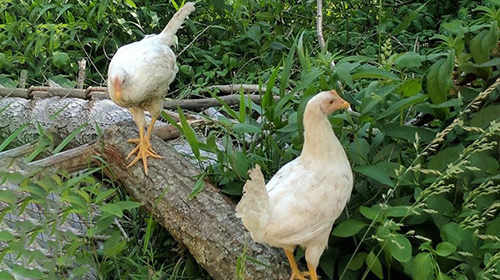 Both Bantam and Rhode Island Red chicken breeds tend to live contentedly in a confined space and do necessarily require free ranging that can really only be accomplished in a rural setting.
Both Bantam and Rhode Island Red chicken breeds tend to live contentedly in a confined space and do necessarily require free ranging that can really only be accomplished in a rural setting.
The Rhode Island Red is a multi-purpose chicken breed, meaning it is often raised to produce both meat and eggs. This is why Rhode Island birds are often kept by both preppers and homesteaders who have only a backyard or small acreage property.
The only downside to keeping Rhode Island Red chickens is the lack of maternal tendencies of the big brown egg laying hens. Bantam hens are often kept alongside the Reds because they are beautiful bird mommas are great sitters and almost always willing to adopt extra eggs. Bantam chickens are smaller than other often kept breeds and they lay small white eggs – but still are covered by homesteading families for their avid sitting tendencies.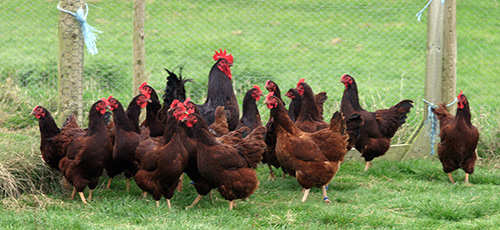 White Leghorn and Buckeye chicken breeds are ideal for large survival homesteads and preppers with at least five acres of land. These large multi-purpose birds will provide moist and tender meat and rich eggs.
White Leghorn and Buckeye chicken breeds are ideal for large survival homesteads and preppers with at least five acres of land. These large multi-purpose birds will provide moist and tender meat and rich eggs.
Buckeye chickens, a heritage breed, lays large brown eggs and Leghorns lay large white eggs. Both breeds have roosters that tend diligently to their flock of hens and are willing to fight to the death to protect them.
White Leghorn roosters are often deemed to be rather unfriendly, but this has not been my personal experience. My two Leghorn roosters are rather friendly with me and will even perch on my shoulder during turn out and put up time. But, and this is a big but, they do not share the same level of love with everyone who enters their barnyard domain that is not a child.
Chickens are relatively inexpensive to keep, especially if you can free range. Chicks of common breeds typically cost $5 or less to buy. A coop and run can be purchased or built for less than $300 to house a small flock that includes one rooster and several mature hens. A bag of chick or chicken feed generally costs between $10 to $15 and can keep a flock of 12 well fed for about two weeks.
Related: DIY Chicken Tunnel (Step-by-Step Guide)
Ducks And Geese
Duck eggs are simply deliciously rich – chalk full of cholesterol, but yummy in baking recipes all the same. Because duck eggs are larger than chicken eggs, you will need to either use a recipe with a conversion for using such eggs, or do a little bit of cooking math yourself to get your dish to turn out exactly right.
Because ducks are almost always raised strictly for meat purposes, there are no real multi-purpose breeds. The Pekin duck is one of the most popular breeds by both homesteading preppers and chefs at upscale restaurants.
Pekin ducks, be they the jumbo or standard version, grow large and produce a moist meat that is far less oily than some of their peers. The Pekin lays quality eggs, but like the Rhode Island Red, typically shows little to no interest in sitting on them. Occasionally a female Pekin duck will drop an egg and ignore it – allowing it to get smashed inside the coop or run.
To create a growing flock of these meat ducks, you will need to purchase an incubator (about $85 to $125 for a self-turning version) and snag the eggs before they are left exposed to the elements so long they will not hatch. I once tried to coax a Banty hen to sit a duck egg. She gave it the old college try, but that single large egg simply would not fit under her with all of the eggs the hen was already caring for in her nesting box.
Both the Pekin and Khaki Campbell breeds are consummate layers. The Indian Runner breed consistently lays quality eggs as well, but the eggs are somewhat smaller and not white like the breeds noted above lay, but a beautiful blue to green color.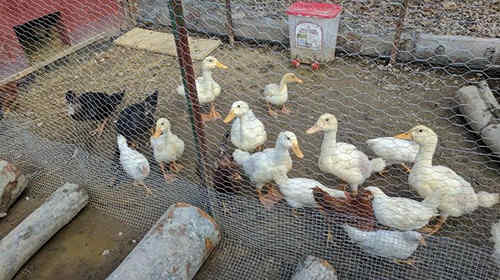 I have always kept my chicken and ducks in the same coop and run without any problem – but not everyone is so lucky. If you introduce a rooster or even a spiteful broody hen into the coop, a duck could get injured or killed. I start my chickens and ducks in the same brooder from day one, which is probably why they cohabitate so well. I feed my combined flock the same chick starter and layer crumble feed instead of scratch that is not really good for ducks because it can get stuck in their crop and cause a delay infection.
I have always kept my chicken and ducks in the same coop and run without any problem – but not everyone is so lucky. If you introduce a rooster or even a spiteful broody hen into the coop, a duck could get injured or killed. I start my chickens and ducks in the same brooder from day one, which is probably why they cohabitate so well. I feed my combined flock the same chick starter and layer crumble feed instead of scratch that is not really good for ducks because it can get stuck in their crop and cause a delay infection.
Even if you are not a rural prepper, there is still a good chance you can keep ducks as part of your survival livestock plan. Although ducks would prefer a nice large pond or creek to swim in, a small flock will enjoy their lives just fine by having a baby pool placed inside their run.
Ducks drink a lot more water than chickens and release a significantly larger amount of body waste – so a little more time is required in your weekly husbandry routine to make sure they have fresh water and are living in sanitary conditions.
Geese should not be kept in a housing unit with chickens and depending upon the temperament of the geese, even ducks. It would be virtually impossible to keep geese anywhere but on rural acres.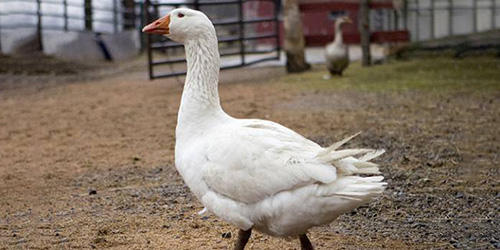 When they are young, geese would be content with a small space to roam and a baby pool, but as they grow would demand more water to spend their days enjoying. Geese are typically a free-range type of livestock, but like peacocks, could be kept and breed in a run if it was both large and tall.
When they are young, geese would be content with a small space to roam and a baby pool, but as they grow would demand more water to spend their days enjoying. Geese are typically a free-range type of livestock, but like peacocks, could be kept and breed in a run if it was both large and tall.
Unlike most breeds of meat ducks, geese can and will fly. The best material to use when creating a good run would be chain-link fencing that is at least six feet tall and covered by bird netting.
Geese will honk loudly if they sense danger and often give chase and use their rounded beaks to “bite” the intruder. A goose nip really does hurt, especially if inflicted on a child tagging along to help with barnyard chore. My daughter has a scar on her thigh from an attack by a goose she had petted 100 times before on her in-law’s farm. Geese tend to be fickle birds.
Related: How Much Land Do You Need to Be Self-Sufficient?
Guineafowl
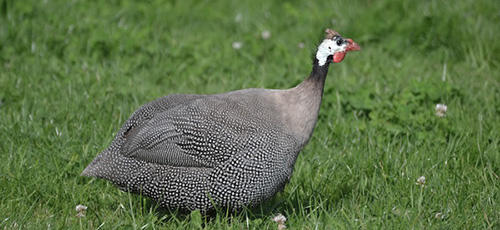 Guineas are just awesome little weird-looking birds. They can be eaten for meat and eggs, but no one really keeps them for those reasons…at least not in a post-SHTF world.
Guineas are just awesome little weird-looking birds. They can be eaten for meat and eggs, but no one really keeps them for those reasons…at least not in a post-SHTF world.
Guineas are often referred to as sacrificial lambs, but I have said many times, I prefer to herald them as my barnyard assassins. The birds meander about in a pack and look at your chickens and ducks as their charges – or at least the territory they all share.
Baby guineas are called keets. They are incredibly smaller, fragile, and slow growing than chicks and ducklings. Therefore, I keep keets in a brooder right next to the one the chicks and ducklings are in and do not put them all together.
I made this mistake once as a newbie keeper and wound up with a lot of squished guineas. The guinea squishing still happen because they pile so tightly close to and on top of each other even when in their own brooder, but to a far lesser degree.
You can keep your guineas (at least I have) in the same coop and run as your chickens and/or ducks, but that is not necessary unless the weather gets really bad in the winter. Guineas should be left out on patrol so they can keep predators from getting even close to your coop.
Guineas will attack (I mean that in every sense of the word) snakes, mink, rats, hawk, weasels, skunks, possums, and even the occasional raccoon that gets too close to their home base. It is not unusual to see guineas roosting not in trees (which they love to do) but on top of your coop to remain on duty even as they sleep.
I keep the guineas in a brooder even after they are no longer keeps to teach them their territory before letting them out to free range. When they are in the large brooder next to the coop and run, they get to know all the animals, sights, sounds, and smells of the barnyard. When I do release them, the guineas already know their geographical parameters and as well as what does and does not belong in the barnyard.
 You must expect to lose a lot of guineas throughout the year, but take solace in the number of meat and egg birds the diehard protector is able to save. Keeping guineas in suburbia probably will not be allowed. They get incredibly loud and screech in a high-pitch tone when they sense danger and will run to the sidewalk and beyond to deter a threat.
You must expect to lose a lot of guineas throughout the year, but take solace in the number of meat and egg birds the diehard protector is able to save. Keeping guineas in suburbia probably will not be allowed. They get incredibly loud and screech in a high-pitch tone when they sense danger and will run to the sidewalk and beyond to deter a threat.
Related: This Super Root Preserves Meat Indefinitely!
Turkeys
I do not keep turkeys on our survival homesteading retreat. I have thought about it, but always decide doing so is far too much work and potential money loss. We have copious amounts of wild turkeys in our woods. I believe our time and money is better spent hunting and preserving the wild turkeys than attempting to raise any.
Why? Well, turkeys, especially young ones, are likely the least intelligent bird in the poultry world. I simply do not have the time to spend teaching a baby turkey (poult) how to survive – like how to hold its head so it doesn’t drown when in the run during a rain. Yes, they can sadly be just that dumb.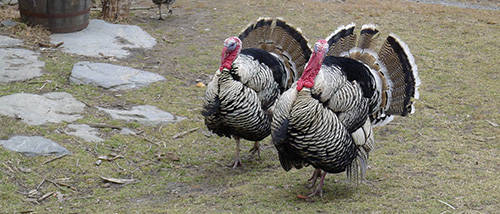 Also, because turkeys can be mean. Not all turkeys, or course – I hate to stereotype, but they tend to be far more willing to peck than chickens and have a far larger beak…it hurts.
Also, because turkeys can be mean. Not all turkeys, or course – I hate to stereotype, but they tend to be far more willing to peck than chickens and have a far larger beak…it hurts.
Keeping poults in the same brooder as my ducks and chickens would likely lead to carnage. Because turkey need a high protein game bird feed, another variety of grain would have to be purchased and stored separately – even on our 56-acre survival retreat, storage space can be limited.
Mature turkeys absolutely cannot be kept in the same coop and run as chickens and ducks, which creates yet another space issue and added expense. Unlike chickens and ducks, keeping a turkey in a small town or suburban backyard would probably violate local ordinances – even in right to farm states.
On the plus side, if you are not deterred by the lack of intelligence that can trump self-preservation tendencies in poults, have the space for an extra coop and large run, and don’t mind pecking scars, turkey produces a wonderful tasting meat and typically range in weight from 20 to 30 pounds.
Related: How to Build a Smokehouse In Your Backyard (with Pictures)
Quail
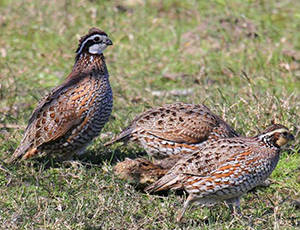 We also do not keep quail because they roam free in our woods alongside the pheasants. You cannot, or at least should not, house quail with chickens. The smaller birds can become a target from roosters more so than ducks because of their decidedly nervous nature.
We also do not keep quail because they roam free in our woods alongside the pheasants. You cannot, or at least should not, house quail with chickens. The smaller birds can become a target from roosters more so than ducks because of their decidedly nervous nature.
Quail hens produce about 230 eggs per year on average, making them a steady supply of small, but tasty eggs. A quail does not need nesting boxes and perches, in fact they will tend to ignore them if provided.
Like pheasant, qual prefer to hide among the grass and lay their eggs on the ground. A small run with some grassy areas would suit a high-strung quail just fine. Place a couple of cinder blocks in the housing unit or run to give the birds a place to hide and feel safe – this is where you will almost always find both the birds and their eggs.
Because quail take up little space and are incredibly quiet members of the poultry world, they are an ideal survival livestock choice for small town, suburban, and perhaps even urban, preppers.
Related: Six Steps To Urban Self-Reliance and Freedom
Ostriches And Emus
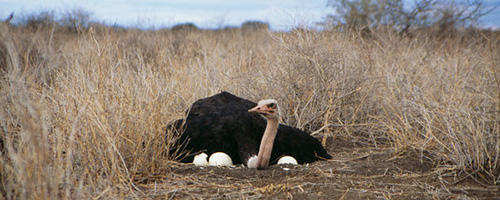
Once again, this is not the type of survival livestock that could be kept anywhere but on rural acreage. There is an emu farm in my rural county. One got loose a few years ago (they can run up to 30 miles per hour) and caused a state route to be closed down half a day while about 25 people tried to catch it.
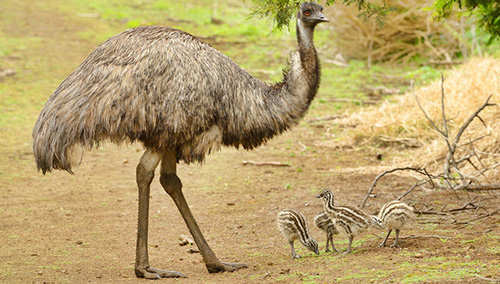
Both an ostrich (can run up to 45 miles per hour) and an emu can grow to be between 8 to 10 feet tall. In addition to biting with their large and thick beaks, they also kick. It is not a tiny little kick but one that is far more akin to that of a horse or kangaroo. The four-inch claws they are willing to use to defend themselves when they sense a threat hurt too. An ostrich kick has been rumored to be strong enough to kill the lion they are trying to outrun in their native habitat, but I cannot attest to the validity of that claim.
Because of the weight, strength, and habitat needs of either an emu or an ostrich, housing even a small hard can take up a lot of space and be quite expensive. Livestock insurance is something you should definitely consider. If your ostrich gets loose and kicks a child or cause a car wreck, the lawsuit you would have to battle could be quite extensive and you would probably lose.
The meat from either an emu or an ostrich is a red meat that is finely textured, but similar to beef. In all honesty, if you want some nice red meat, buy some cattle, they will really be a lot less dangerous and bothersome to keep.
Related: Top 9 Animals to Raise in a Post Apocalypse World
Just The Facts
Poultry Egg Laying Comparison
Female turkeys and geese are prone to “going broody” and want to sit on large clutches of eggs to hatch them instead of laying more, causing a decrease in the annual yield.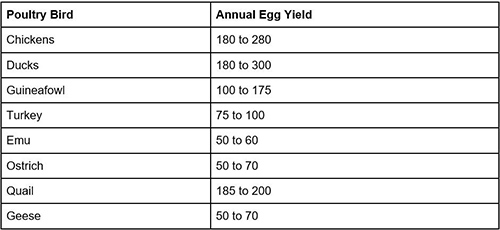
Poultry Bird Meat Production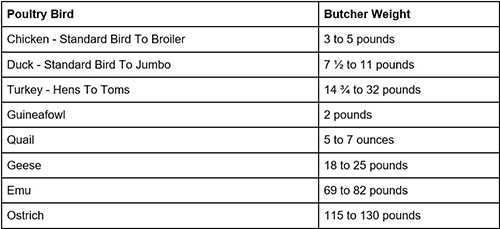 Poultry Raising Costs
Poultry Raising Costs
Because chickens and ducks can reach butcher weight in as little as 9 to 11 weeks for broiler breeds, the costs associated with keeping them can be substantially less than other poultry birds.
The husbandry costs for raising free range birds of any type will be significantly less than the expense associated with caged poultry of any type. If you can butcher your own meat, the husbandry costs will go down once again.
The figures used in the chart below were factored for cage birds processed by a professional butcher. The cost to raise a bird will also vary depending upon how many weeks it takes a particular breed of the poultry bird, to mature.
The shelter- coop and run, feeder and waterer costs are based upon a flock of four birds.
*Because guineafowl are typically kept to protect the meat bird flock, they either free range exclusively or are kept in the same coop and run to ward off predators. The shelter expenses listed for these birds only reflect adding onto an existing coop to make room for them if they cannot roam free.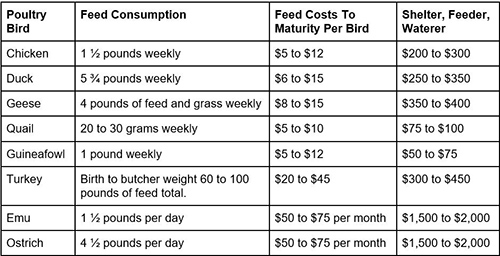
Related: How to Dehydrate Chicken for Survival (With Pictures)
Cost Of Purchasing And Housing Chicks
* The costs reflected in this table are for standard chicks. The price for rare, heritage, and jumbo breeds of each poultry bird will typically be higher than the cost associated with standard birds whether or not they are sold as sexed or straight run. When purchasing poultry birds from a hatchery, the more you buy the cheaper the per chick (or juvenile or mature breeder) price.
*If incubating your own chicks to grow your flock, expect to spend $85 to $300 for an incubator, brooder, and heat lamps. Incubator prices vary based upon both dimension (number and type of eggs it will hold) and whether or not it is an automatic egg turning or manual turning version.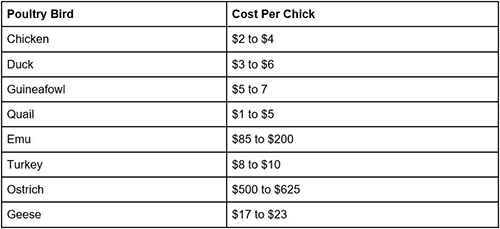 In addition to the typical husbandry cost (shelter, run, feed, waterer, feeder) you should also factor several other costs into your homesteading budget. The “hidden costs” associated with keeping any poultry bird include straw ($3 to $5 per square bale) or some type of bedding that is removed weekly to keep the nesting boxes and coop hygienic and prevent the spread of disease.
In addition to the typical husbandry cost (shelter, run, feed, waterer, feeder) you should also factor several other costs into your homesteading budget. The “hidden costs” associated with keeping any poultry bird include straw ($3 to $5 per square bale) or some type of bedding that is removed weekly to keep the nesting boxes and coop hygienic and prevent the spread of disease.
You will also need to purchase some common manual farm tools like a shovel and pitchfork to clean the coop and run and to move hay. Because feed bags typically weigh 50 pounds, I highly recommend buying a wagon with all-terrain tires to help you tend to even a small flock.
A wagon that can also function as a dump cart and it would be ideal for both hauling fresh straw and feed as well as mucking out the coop and run. Metal cage style wagons commonly sold at agriculture stores are nice, but when you are going to be dealing with damp straw and heavy piles of droppings, such wagons will eventually rust and rarely come with a dump feature or rugged terrain tires.
If the flock does not free range or you live somewhere with harsh winters, you will need to factor an increase in the monthly water bill (or electric bill if you have well water) into your husbandry budget. Ducks will need a small pond or baby pools that are cleaned and refilled regularly, inside their habitat.
Geese must have a constantly accessible water source of some type (larger than a duck’s water source) inside their habitat. Unlike ducks, geese are not usually willing to get into moving water in a creek and prefer still pond water.
There are pros and cons to keeping nearly all types of poultry as part of your survival livestock plan. Keeping more than one type of livestock to vary the taste of your meat and eggs is a good idea, but only if doing so does not require a lot of extra space, time, and money on your part.
Choosing the right type of poultry bird to keep for your location and means will play a substantial role in how successful your husbandry efforts will be. Start with a small flock no matter what type(s) you choose and master the required husbandry techniques (including livestock first aid) before breeding or investing in more birds.
You may also like:
 How To Can Chicken (Step By Step Guide With Pictures)
How To Can Chicken (Step By Step Guide With Pictures)
What Happens When You Pour Salt Into A Cabbage (Video)

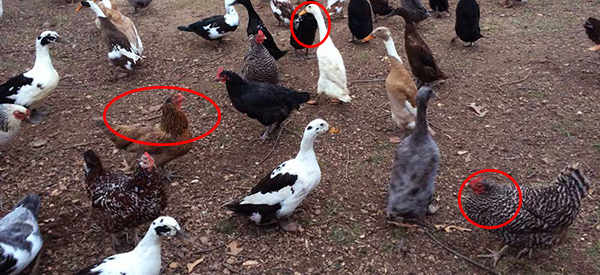




















Thank you so much for your information. I had started to think about raising some chickens for organic eggs and heard about some that would attack snakes and such, but had no idea about some of the other things. That idea was drowned because the place I had my RV on was sold and I moved into a more rural setting with more neighbors. But when I read this article, I got to wondering about it again. Which chicken do you think would be the quietest for a suburban setting with a lot of people around? Thanks for the information.
All chickens (hens) are quiet, it’s the rooster(s) that make disturbing noise’s that should concern you in a suburban neighborhood, just realize of course, that your hens will not lay fertile eggs w/out a rooster. But while on that subject, gift you neighbors some eggs regularly and I’m sure you’ll hear very few, if any complaints. (you can also offer compost / fertilizer after cleaning the pen.)
Wow! Great article by someone who apparently is walking the walk and knows what she is talking about. This article is a must print for me. Thanks, Tara, for your highly informative and detailed article. It is greatly appreciated.
I think pigeons and doves should have been added to that list. That is what they used in the day of the knights in the castles.
There is a lot of great information in this article, yet what is said here about turkeys is very sad and completely untrue. While commercial turkeys have had the brains bred out of them, heritage turkeys are easily the most engaging and intelligent birds I’ve ever experienced first hand. I once believed all the myths repeated here myself, yet six years ago my husband brought home 8 Narragansett plus 8 midget white turkey poults to raise. Wow, what fantastic birds! They didn’t need any special instruction on how to eat or drink, instead they craved toys to play with until they were old enough to move outside. We’ve never lost any to drowning despite multiple flash floods and six kiddie pools filled to the brim for the ducks.
In my experience heritage turkeys are mischievous, certainly not stupid. Some learn their own names and come when called, many enjoy being picked up and carried (we’ve had hens who refuse to go to bed unless you carry them like queens), and they’re always around to “help” with chores (they’ll run off with small hand tools and pluck zip ties out of your pockets). Over the years we have had at least a dozen Toms, all very friendly to humans although we had to eat three that were guilty of attacking other birds (a delicious solution to a not very big problem overall). Our current four 30+ pound Toms follow us around and aren’t opposed to being picked up either, especially if there’s a camera involved (turkeys love anything shiny and will look straight into a camera lens, great for taking pictures).
As of this writing we have four little poults in the living room brooder, now nine days old. We believe our turkeys are particularly friendly and interactive since they hear human voices while still in the incubator, then spend weeks in the living room trying to get our attention. We hang parrot toys and bird-safe mirrors inside the brooder to reduce boredom, although their favorite activity is trying to get us to pay attention to them. They have different chirps and whistles to express fear, happiness, questions, and alarms that we’ve learned to mimic — and they’ll answer back when we mimic their calls.
The myths repeated about turkeys just aren’t true for anyone who had raised heritage breeds (*not* the factory farm commercial varieties). They are by far our favorite farm birds, and haven’t had any issues raising them in the same yards with chickens. No, they don’t like ducks very much… but our turkey and duck flocks simply avoid each other.
We’ll never do guinea fowl again since they’re too loud and attract too many predators (which is how all 16 of our guineas eventually died over a two year period). On the other hand we’re extremely pleased with our Dominique chickens, haven’t lost any to predators even though they free range in the forest all day, they’re the only birds we’ve had that put themselves to bed every night, and they are fantastic egg producers.
Anyone who has hunted wild turkeys will tell you that they are sly birds and are a real challenge to hunt. There is an urban legend that wild turkeys were so much of a challenge to hunt that Benjamin Franklin thought the wild turkey should be made the national bird rather than the bald eagle.
Chris, thanks for your post. It is also a print out and keep for me. It has been so long since I had any livestock other than koi that I have forgotten whatever it was that I knew. Unlike some some suburbia dweller, however, I do know that fowl do not grow on styrofoam trays nor does beef nor pork.
I agree 100%. We are raising heritage turkeys, Bourbon Reds, and they are anything but stupid. I pet them, hold them, and they even follow me around. The toms are friendly and curious. Way more intelligent than I expected. We love our turkeys!!!
Wow, Chris F! I always wondered about how much of the stupidity of domesticated turkeys was true, given the intelligent wariness and cleverness of the wild turkeys around. Thanks for your down-to-earth information!
My duck would chase my turkey. It was so funny. The Tom would start to chase the geese and they would run then the duck would step in and chase the him off. The duck was the smallest but he ran the show. LOL
‘Nother great article, lots of insightful comment, thanks!
Don’t think I will be raising ducks.
One bird you failed to mention is the Muscovy. Although not a true duck, they are called that. It is a large bird and silent. Lay many eggs and raise a large brood. Again, they only need a wading pool.One caution, they are excellent fliers so if you don’t have much land, they will need pinioning but will return home by evening. they prefer roosting on the roofs and trees.
You missed one bird that my grand parents and father raised, pigeons. Larger than quail but smaller than chickens you get multiple hatchlings year round. Daddy preferred to harvest the squab, youngsters that are in the process of fledging.
A tiny aside for anyone interested in raising ducks for their succulent eggs. Fantastic for baking and cooking, the whites of the eggs are rubbery when fried. The yolks are the tastiest ever, though.
Geese…the best ‘watch-dogs’ nature ever came up with.
This past spring, after losing my garden to grasshoppers, we executed “The Nuclear Option” and bought a flock of 10 Guinea keets. The potential for eggs and meat was a secondary consideration. The primary purpose for having them is to eat bugs! And they are very good at their job. They are dumber than a box of rocks in some respects and fairly clever in others. The breeder we got them from warned us that we would probably lose one the first night and she was right. That left us with 9, 2 of which were special colors and 7 of which were Pearls, the common gray-brown with white polka dots. She also said her husband calls them sacrificial birds but that they set up such a racket when a predator enters their territory that it gives the chickens time to run into the coop for safety, meanwhile, the slowest of the Guineas is likely to get taken. We have since lost 4 more, so our little flock is down to 5, one Buff Dundotte and 4 Pearls. The Buff seems to be the boss at this point.
They squawk VERY loudly when you are inside their house with them (it reverberates off the walls) but when they are outside, while they free range and eat bugs and weed seeds, I find their chirps to be rather soothing.
Their antics are entertaining, too. They appear whenever we show up near their territory – the gardens, the orchard and the bird house, and follow us around, hopping up into the UTV, pecking at bugs in the orchard, sitting on the carport roof at the guest house above the gardens, wandering up onto the deck of the guest house. Their running gait is comical and they are QUICK! Every so often, they will suddenly raise a ruckus and fly up onto a roof or the ridge above the orchard or the hill behind their house. And if a predator shows up, usually a coyote, they will fly up onto the roof of their bird house or into the upper branches of the hackberry and mesquite trees and squawk to let us know that the “bad guy with big teeth” has shown up. They didn’t seem to mind the feral hog that took up residence under the deck of the guest house and he didn’t seem to bother with them. One day, when I showed up and scared him out of there, he ran right by them. None of them even stopped looking for bugs and he was too startled to stop and look at them.
They have learned that dinner is served in the evening so, when the lights inside the birdhouse turn on (they are on a timer), it is time to stick around the house and go inside as soon as one of us goes in to put out dinner. The automatic “pop” door opens in the morning and they can fly out of the 6′ tall chain link kennel beside the house to start their extermination duties for the day. They go in and out at will to get a drink and some crumble. When we get outside to start chores, the first stop is usually down to the birdhouse to open the gate of the kennel. That just makes it easier for them to get inside their house. The birdhouse and gardens are half a mile from the house where we live so their noise doesn’t bother us. So far, they have not found their way to our house.
I don’t know how many of them or even if any of them will survive until spring but we already are on the breeder’s list to get more when the keets hatch. We might augment the flock with some chickens by then, too. Ducks are not in the picture for us – water is too scarce and my DH doesn’t like dark meat. And since I can’t eat turkey meat, I am not sure they are a good bet, either. Anyway, we have wild turkeys, quail and doves in abundance. It would probably be more economical to go out and hunt them than to raise any of them.
The breeder told us that the Guineas that are not handled a lot as keets and therefore won’t let you handle them as adults, seem to stay safer than the ones that are acclimated to human handling. We will have to experiment with that next spring, maybe put leg bands on two or three and treat them differently as keets. We’ll see if they act differently as adults.
Well, I am bummed out tonight. We appear to have lost the Buff Dundotte, the last of the 4 Guineas we named (Larry, Moe, Curly Toe [she had a deformed foot] and Seven of Nine [she was the runt of the 7 Pearls]). When ZI went down to put them to bed this evening, the 4 Pearls were up in trees and there was no sign of Moe. I guess she is in the tummy of either a coyote or a bobcat. At this rate and depending on how bad a winter we have, I think we might be starting the Spring with a whole new flock. Guess we will pick up a few more keets next time.
Good article, but one thing: You missed the Rhea. these are our version of the emu, but turn into pets easily. Males brood the eggs and young, and females can lay 100-150 eggs a year if the dry season is long enough. niio
Thank you for this article, it is great. I have raised chickens and turkeys. I’m considering chukar and pheasant. Now that I have read your article I will consider adding Guinea’s to the flock. My turkeys were gentle giants who lived peacefully with my chickens. My two turkey hens would however fight over my male, but they were kind to the chickens. If I decide to raise more turkeys I would choose wild turkeys who are smarter than their domestic cousins.